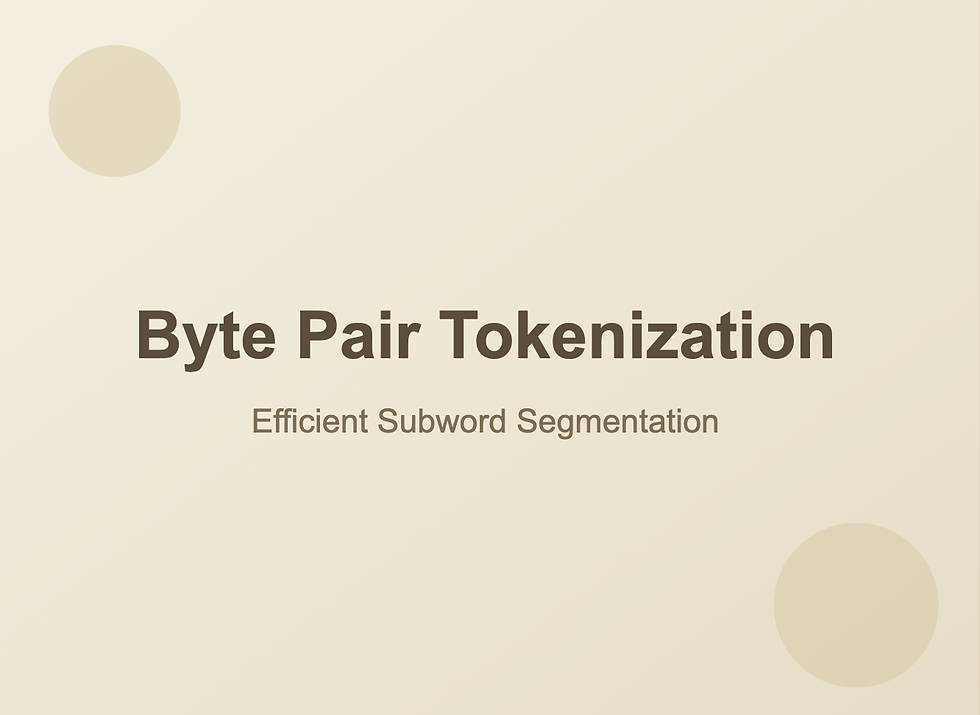BPE Dropout
- Atharv Yeolekar
- Jun 30, 2024
- 4 min read
Overview
BPE dropout is a regularization technique for subword tokenization, introduced to improve the robustness of neural machine translation models. It's an extension of the standard Byte Pair Encoding (BPE) algorithm that introduces randomness into the tokenization process during training.
Key points
Applies to BPE and its variants (like WordPiece)
Used during training, not inference
Introduces multiple possible segmentations for each word
Acts as a data augmentation technique at the tokenization level
BPE Dropout Workflow
Standard BPE Process
First, let's recall how standard BPE works:
Start with a vocabulary of individual characters.
Iteratively merge the most frequent pair of tokens.
Apply these merges deterministically during tokenization
BPE Dropout Modification
BPE dropout modifies step (c) of the standard process:
For each word during training:
Randomly drop some merges with a probability p (typically 0.1)
This results in a different segmentation each time
The dropout is applied independently for each word in each training batch.
Detailed Algorithm
Let's walk through the process with an example:
Word: "unbelievable"
Standard BPE merges (hypothetical):
'u' + 'n' → 'un'
'a' + 'ble' → 'able'
'be' + 'lie' → 'belie'
'un' + 'belie' → 'unbelie'
'unbelie' + 'v' → 'unbeliev'
BPE dropout process
For each merge, generate a random number r between 0 and 1
If r < p (dropout probability), don't apply this merge
Apply remaining merges
Possible outcomes with BPE dropout
"unbeliev able" (if merge 2 is dropped)
"un belie v able" (if merges 3 and 5 are dropped)
"u n belie v able" (if merges 1, 3, and 5 are dropped)
Training Process
During model training:
For each training batch:
Apply BPE dropout to create tokenized input
Feed this to the model
Compute loss and update model parameters
The model sees different segmentations of the same word across epochs
Inference Process
During inference (after training):
Use standard BPE without dropout
This ensures consistent tokenization for the same input
Understanding Dropout Probability in BPE Dropout
Basic Concept
In BPE dropout, the dropout probability (p) represents the likelihood of not applying a particular merge operation during the tokenization process. It determines how often the algorithm will "drop out" or skip a merge that would normally occur in standard BPE.
What Different Values Mean
p = 0.1 (Typical Value)
Meaning: Each merge operation has a 10% chance of being skipped.
Effect:
Introduces moderate variability in tokenization.
Most merges still occur, maintaining a balance between standard tokenization and increased variability.
p = 0.0 (No Dropout)
Meaning: No merges are ever skipped.
Effect:
Equivalent to standard BPE.
Always produces the same tokenization for a given word.
p = 1.0 (Full Dropout)
Meaning: All merges are always skipped.
Effect:
Results in character-level tokenization.
Each word is broken down into its individual characters/bytes.
p = 0.5 (High Dropout)
Meaning: Each merge has a 50% chance of being skipped.
Effect:
Introduces high variability in tokenization.
Significantly different segmentations of words in each iteration.
Example
Let's consider the word "unbelievable" with the following BPE merge rules:
'u' + 'n' → 'un'
'be' + 'lie' → 'belie'
'able' (already in vocab)
'un' + 'belie' → 'unbelie'
'v' + 'able' → 'vable'
Here's how different p values might affect tokenization:
p = 0.0 (Standard BPE)
Always: ['unbelie', 'vable']
p = 0.1
Possible outcomes:
['unbelie', 'vable'] (most common)
['un', 'belie', 'vable']
['unbelie', 'v', 'able']
['un', 'belie', 'v', 'able'] (rarely) ['u', 'n', 'be', 'lie', 'v', 'able']
p = 0.5
Possible outcomes (more varied):
['un', 'belie', 'v', 'able']
['u', 'n', 'belie', 'vable']
['un', 'be', 'lie', 'v', 'able']
['unbelie', 'vable']
['u', 'n', 'be', 'lie', 'v', 'able']
p = 1.0
Always: ['u', 'n', 'b', 'e', 'l', 'i', 'e', 'v', 'a', 'b', 'l', 'e']
Impact on Training
Low p (e.g., 0.1)
Slight increase in tokenization variability.
Model sees minor variations, improving robustness without drastically changing the input.
Medium p (e.g., 0.3-0.5)
Significant increase in tokenization variability.
Model is exposed to many different subword combinations, potentially improving generalization to unseen words.
High p (e.g., 0.7-0.9)
Very high variability, often resulting in character-level or near-character-level tokenization.
May be beneficial for tasks requiring character-level understanding but can slow down training.
p = 1.0
Effectively becomes character-level training.
Useful for comparing with subword-level approaches but typically not used in practice for BPE dropout.
Choosing the Right p
The optimal p often lies in the range of 0.1 to 0.3.
It should balance introducing beneficial variability without disrupting the learning of common subword patterns.
The choice depends on factors like language morphology, task requirements, and dataset characteristics.
Remember, BPE dropout with any p > 0 is only applied during training. During inference, standard BPE (equivalent to p = 0) is used to ensure consistent tokenization.
Pros & Cons of BPE Dropout
Pros
Improved Robustness: Exposes the model to various valid segmentations, making it more resilient to different word forms.
Better Generalization: Enhances the model's ability to handle rare or unseen words by learning from diverse subword combinations.
Data Augmentation: Acts as a form of data augmentation at the tokenization level, effectively increasing training data diversity.
Reduced Overfitting: The variability in tokenization helps prevent the model from overfitting to specific segmentations.
Enhanced Compositionality: Improves the model's understanding of how subwords compose to form words.
Adaptability: Particularly useful in low-resource scenarios or when dealing with morphologically rich languages.
Cons
Increased Training Time: The random dropout process can slow down training compared to standard BPE.
Potential Instability: If not tuned properly, it might lead to unstable training or slower convergence.
Complexity: Adds another hyperparameter (dropout probability) to tune, increasing model complexity.
Resource Intensive: Requires more computational resources due to the dynamic nature of tokenization during training.
Inconsistency: The variability in tokenization might make it harder to interpret or debug model behavior during training.
Limited to Training: The benefits are mainly during training; inference still uses standard BPE.




Comments